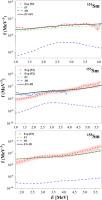On the low-energy electromagnetic dipole modes in 151,153,155Sm Nuclei
IF 4.6
2区 物理与天体物理
Q1 PHYSICS, MULTIDISCIPLINARY
引用次数: 0
Abstract
The recently observed low-energy magnetic dipole (M1) and electric dipole (E1) excitations in deformed 151,153,155Sm are theoretically analysed. Rotational Invariant (RI-) and Translational-Galilean Invariant (TGI-) Quasiparticle Nuclear Model (QPNM) are used in the calculation of M1 and E1 properties, respectively. Both theories consider monopole pairing between nucleons, and the deformed Woods-Saxon potential is used as the mean-field potential. Pyatov's symmetry restoration procedure is applied in these models to eliminate the spurious modes from the intrinsic nuclear excitations. Model calculations show that although E1 transitions dominate the low-energy dipole spectra of 151,153,155Sm, many low-lying M1 transitions exist in these nuclei. It is shown that the most significant contribution to E1 and M1 excitation comes from ΔK=±1 transitions. The theory satisfactorily reproduces the gross features of low-lying dipole modes determined from the Oslo Method analysis of the experimental spectra.

关于 151、153、155Sm 核的低能电磁偶极模式
对最近在变形 151、153、155Sm 中观测到的低能磁偶极(M1)和电偶极(E1)激发进行了理论分析。在计算 M1 和 E1 特性时,分别使用了旋转不变(RI-)和平移-伽利略不变(TGI-)准粒子核模型(QPNM)。这两种理论都考虑了核子之间的单极配对,并使用变形伍兹-撒克逊势作为平均场势。在这些模型中应用了 Pyatov 对称性恢复程序,以消除来自内在核激发的虚假模式。模型计算表明,尽管 E1 转变在 151、153、155Sm 的低能偶极谱中占主导地位,但这些原子核中还存在许多低洼的 M1 转变。研究表明,对 E1 和 M1 激发贡献最大的是ΔK=±1 转变。该理论令人满意地再现了根据奥斯陆法分析实验光谱所确定的低洼偶极子模式的总体特征。
本文章由计算机程序翻译,如有差异,请以英文原文为准。
求助全文
约1分钟内获得全文
求助全文
来源期刊

Chinese Journal of Physics
物理-物理:综合
CiteScore
8.50
自引率
10.00%
发文量
361
审稿时长
44 days
期刊介绍:
The Chinese Journal of Physics publishes important advances in various branches in physics, including statistical and biophysical physics, condensed matter physics, atomic/molecular physics, optics, particle physics and nuclear physics.
The editors welcome manuscripts on:
-General Physics: Statistical and Quantum Mechanics, etc.-
Gravitation and Astrophysics-
Elementary Particles and Fields-
Nuclear Physics-
Atomic, Molecular, and Optical Physics-
Quantum Information and Quantum Computation-
Fluid Dynamics, Nonlinear Dynamics, Chaos, and Complex Networks-
Plasma and Beam Physics-
Condensed Matter: Structure, etc.-
Condensed Matter: Electronic Properties, etc.-
Polymer, Soft Matter, Biological, and Interdisciplinary Physics.
CJP publishes regular research papers, feature articles and review papers.
 求助内容:
求助内容: 应助结果提醒方式:
应助结果提醒方式:


